Elihu Thomson, Man of Many Facets
Reprinted from "Crown Jewels of the Wire", February 1986, page 28
1983 IEEE. Reprinted with permission from IEEE SPECTRUM, Vol. 20, No. 10, pp. 72-75,
October, 1983.
When he was still a high-school student, Elihu Thomson wrote, "There
is scarcely a day passing, on which some new use for electricity is not
discovered. It seems destined to become at some future time the means of
obtaining light, heat, and mechanical force." In making this remark, Thomson could well have been anticipating his own future, for few men discovered
more new uses for electricity than he. Along with Thomas A. Edison, George
Westinghouse, and Charles Brush, Thomson helped create the first electric light
and power systems. By the time of his death in 1937, he had come to be
considered by the engineering profession as "indisputably the dean of
American electrical engineers."
A prolific inventor, Thomson acquired 696
patents in a career that spanned five decades. His inventions included a
repulsion-induction motor, electric welding, and improved transformers, all of
which were central to the rapid development of alternating-current
distribution systems. More than just an inventor, though, Thomson was also a
respected scientist, director of engineering and research at the General
Electric Co., and president of the Massachusetts Institute of Technology.
Involved in the growth of modern corporations, educational institutions, and
professional engineering groups, Thomson's career reveals how a capable engineer
and inventor participated in the United States' industrial development in the
late nineteenth and early twentieth centuries.
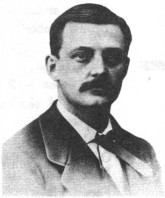
Elihu Thomson was just 23 years old when he stopped teaching at
Central High School in Philadelphia to become a professional inventor. He is
pictured here five years later when he was perfecting his arc-lighting system. |
A promising student
Thomson was born its Manchester, England, in 1853, but at
an early age immigrated with his family to Philadelphia, Pa. Eager to learn, young Elihu
passed rapidly through Philadelphia's public elementary schools and its Central
High School [see ''Science at Central High School,'' p.74]. Unlike other
early American high schools, which emphasized the liberal arts, Central High
concentrated on the sciences; consequently, Elihu took courses in physics,
chemistry, mathematics, and astronomy. Encouraged by his teachers, he set up his
own chemical laboratory at home and organized a junior scientific society. Such studies and activities rapidly
convinced Thomson to pursue a career in science and technology. Upon graduation
from Central with honors in 1870, he spent the next few years establishing
himself as a chemist in Philadelphia.
From chemistry to electricity
Thomson worked briefly in a commercial
chemistry laboratory, then returned to Central High to teach chemistry.
Intensely curious about science and the mechanical arts, he devoted much of his
free time to conducting chemistry experiments and writing brief papers for local
scientific journals. He also built a pipe organ, a telescope, and a camera. Like
other scientific devotees of the time, this young high-school teacher was
especially interested in the discoveries being made in electricity, and he
constructed electrostatic machines and self-exciting dynamos.
In 1877 Thomson
participated in comparative tests of electric-lighting machinery at the Franklin
Institute in Philadelphia, and these greatly enhanced his knowledge of
electrical technology. During the tests he examined several arc-lighting systems
that created a powerful light by passing an electric arc between two carbon
electrodes. To supplement his knowledge of U.S. systems, Thomson visited Europe
in the summer of 1878 and studied the alternating-current arc-lighting systems
of Paul Jablochkoff and Dieudonne Francois Lontin.
A flawed beginning
Based on what he saw in the tests and on his trip, Thomson
decided that he too could construct a practical set of arc lights. Collaborating
with Edwin J. Houston, another teacher at Central High, Thomson designed and
built an alternating-current system in the fall of 1878. In demonstrating their
system at the Franklin Institute, Thomson and Houston employed a crude
transformer to make each arc lamp independent and to transmit power to an
electric motor. Their machinery, although novel, did not perform very well and
failed to impress local businessmen.
Several investors, however, did ask Thomson
and Houston to design a more practical direct-current system that could compete
with the successful arc-lighting equipment of Charles Brush. Anxious to obtain
the capital needed to support their inventive work, they designed a dc generator
and arc lights in the spring of 1879. By incorporating a three-coil armature in
their dynamo, the two teachers were able to construct a commercial lighting
system that avoided the Brush patents. The generator's first commercial test was
in D.B. Fuller's Aerated Biscuit Bakery in Philadelphia, where it powered nine
lights on a series Circuit.
A career as inventor launched
The test was a success and soon attracted
additional financial backers. In 1880 Thomson resigned from Central High to
become a professional inventor. During the next three years he worked for the
American Electric Co. of New Britain, Conn. Soon disappointed by the company's
failure to market his inventions, Thomson next secured funding from several shoe
manufacturers in Lynn, Mass., and moved there in 1883. This new group of
investors was led by Charles A. Coffin, an entrepreneur who provided the
Thomson-Houston Electric Co. with financial and marketing strategies that led to
rapid growth. With Coffin's support, Thomson was able to give his undivided
attention to inventing.
Through the 1880s Thomson perfected his arc-lighting
system by introducing an automatic current regulator. He also designed an
incandescent lighting system to compete with Edison's and promoted the
introduction of alternating current by inventing safety devices for
transformers, an induction-repulsion motor, and a recording wattmeter. His
invention of electric resistance welding in 1886 contributed to the increased
use of electricity in industrial processes and was soon employed in many
mass-production factories. In developing and introducing these many inventions,
Thomson frequently had to negotiate with Coffin and other managers, since they
had different perceptions of the market for new electric equipment. Nonetheless, Thomson and
Coffin were able to reconcile the laboratory with the front office, thereby permitting
the Thomson-Houston Co.
to be competitive in the electrical industry.
In 1892 Thomson-Houston merged
with its major rival, the Edison General Electric Co., to form the General
Electric Co., one of the largest corporations of its time. Coffin became its
president and Thomson stayed on as the new company's chief technical
advisor.
Pioneering research
Thomson's research and inventions helped to establish a
tradition of basic research and product innovation at General Electric. With Thomson's guidance the company hired other inventors and
scientists, including
Charles Van Depoele, Charles Steinmetz, and Willis R. Whitney. In 1900 Thomson
joined with Steinmetz and other company executives to create the General
Electric Research Laboratory, thus formally institutionalizing the research
process. The GE laboratory, the first of its kind in the world, served as a
model for industrial research in other high-technology fields.
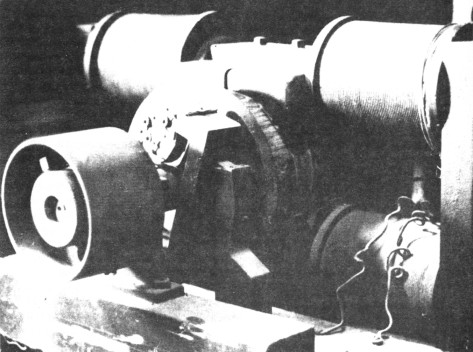
Thomson's first attempt to power several arc lights was by means of a dynamo that used
alternating current and a rudimentary transformer. This machine, co-invented with Edwin J.
Houston while the two were teachers at Central High in 1878, is now in storage at the National
Museum of American History in Washington, D.C. |
As the industrial
research laboratory and teams of engineers took over the development of
electric equipment for GE, Thomson devoted more of his time to science. From developing
high-frequency ac apparatus, he moved easily to the study of liquid air, X-rays,
and quartz optics. In 1896, he made GE a pioneer in the manufacture of X-ray
tubes and power sources, and he showed considerable foresight in investigating
the physiological effects of prolonged exposure to X-rays.
In the area of quartz
optics, he worked with George Ellery Hale in developing large diameter mirrors
for astronomical telescopes. Under Thomson's direction, GE attempted in 1928
to cast the first blank for the 200-inch Mount Palomar telescope, but the
casting proved useless since Thomson was unable to prevent bubbles from forming
when the molten quartz was not uniformly cooled. Because of his steady stream of
research reports and improved scientific instruments, Thomson came to be
considered one of the leading Amencan physical scientists of his day. Impressed by his scientific contributions, one journalist remarked in
Electrical
World in 1904 that "Had Professor Thomson devoted his life to pure science,
he would in this department have conquered a place second to none of the present
generation."
Thomson also participated in professional activities. Early in
his career, as a member of the Franklin Institute -- the most active technological
organization of the nineteenth century -- he gave lectures, served on committees,
and participated in dynamo tests. In 1884 he signed the "call" for
the first meeting of the American Institute of Electrical Engineers, and in 1889
he was elected its fifth president.
In 1908 Thomson succeeded Lord Kelvin as the
head of the international Electrotechnical Commission, where he presided over
the introduction of new standards for electrical measurement. During World War I
Thomson was appointed to the national Research Council, where he assisted in
the first attempt to coordinate scientific research on a national level. Also
concerned with engineering education, Thomson was for many years an influential
member of the governing corporation of the Massachusetts Institute of
Technology in Cambridge, and he was MIT's acting president from 1920 to 1923.
| Picture at the Right: After fusing the Thomson-Houston Co. with the Edison General Electric Co.
to form the General Electric Co. in 1892, Thomson and Charles Steinmetz, shown on a street
corner in Lynn, Mass., in the mid-1890's, helped establish in 1900 the General Electric Research
Laboratory, the first of its kind in the world. |
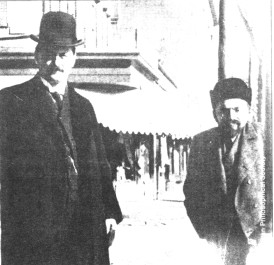
|
A recipient of many awards
Thomson's contemporaries recognized and rewarded
his scientific and technological genius. His peers named him, even before
Edison, a member of the National Academy of Sciences (he was one of a handful of
inventors in the academy). Both the American Philosophical Society and the
American Academy of Arts and Sciences enrolled him as one of their
distinguished members.
The joint American engineering societies gave Thomson
their highest honor, the John Fritz Medal. Internationally renowned as well,
Thomson received the Lord Kelvin Medal from British engineering societies, was
named by the French an Officier et Chevalier de la Legion d'Honneur, and
received the Grashof Medal from the Verein Deutscher Ingenjeure, the German
engineering society. When leading scientists and inventors were discussed in the
popular scientific magazines of the 1910s and 1920s, Thomson was frequently
acclaimed as one of the creators of the new electrical age.
Although he did
research and filed patents through the 1920s, he retired from active
participation in General Electric. Settling into a spacious home in Swampscott,
Mass., Thomson pursued his many hobbies, including astronomy, color photography,
painting, and music. Married twice (his first wife died in 1916), he had three
sons and lived to enjoy grandchildren.
He died in 1937 after several years of
declining health; his loss was greatly mourned by professional engineers who
remembered him as being "second to none among the small group of his
contemporaries upon whose inventive genius the electrical industry was
founded."
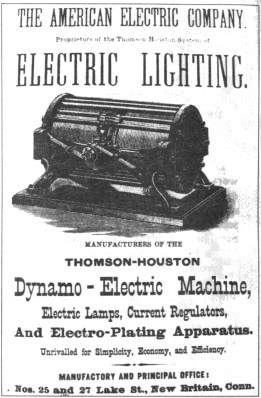
In the New Britain, Conn., city directory, Thomson advertised his spherical armature machine
used in arc-lighting systems for his first company in 1880. The dynamos were built from the
experience Thomson obtained doing the lighting for D.B. Fuller's Aerated Biscuit Bakery
in Philadelphia. |
To probe further
Elihu Thomson is the subject of only one full-length
biography, by David 0. Woodbury, titled Beloved Scientist: Elihu Thomson-A
Guiding Spirit of the Electrical Age, New York, Whittlesey House, 1944. A
convenient bio- graphical source is Karl T. Compton, "Biographical Memoir
of. Elihu Thomson, 1853-1937," National Academy of Sciences' of
Biographical Memoirs, Vol. 21, no.4, 1939.
For general information on the
electrical industry during Thomson's active years as an inventor, see Networks
of Power: Electrification of Western Society 1880-1930, by Thomas P. Hughes, Baltimore and London, Johns Hopkins
University Press, 1983, and The Electrical Manufacturers 1875-1900, by Harold
Passer, Cambridge, Mass., Harvard University Press, 1953.
Thomson left for
historians a rich legacy of manuscripts and artifacts. His personal and business
papers, which numbered over 50,000 items, are at the Library of the American
Philosophical Society in Philadelphia. Many of his early machines are in storage
at the Franklin Institute Science Museum in Philadelphia and at the National
Museum of American History in Washington, D.C. Thomson's bakery dynamo, however,
is on display at the National Museum. Additional Thomson memorabilia may be seen
at the Boston Museum of Science, the Lynn Historical Society, and the
Massachusetts Institute of Technology Museum in Cambridge.
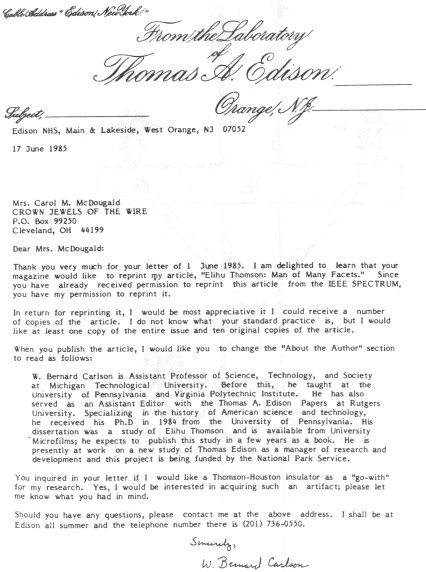
Large Image (178 Kb)
|
